Discovering Paris: what do I need to know before I go?
“A walk about Paris will provide lessons in history, beauty, and in the point of life.” – Thomas Jefferson. With its thousand-year-old history, Paris has accumulated a treasure trove of wonders and evolved a truly iconic culture – all the while picking up a multitude of nicknames along the way. The "City of Love" for example, thanks to its ever-romantic atmosphere, and the "Capital of Fashion" or "Capital of Creation" for being a cradle of haute couture, prestigious design, and for being a historic stomping ground for artists from all over the world. The French capital makes for an ideal destination for a romantic getaway or culture-filled urban escape, and as anyone who has already visited will tell you, its a city that you never tire of. Whether for a long weekend break or a longer holiday, Paris is a multi-sensory getaway full of cosy cafés with Parisian charm, traditional restaurants and bistros serving divine gastronomic dishes by world-class chefs, beautiful streets, architectura and gardens, and a countless number of must-see museums and monuments. In this guide let us provide you with some essential information to plan a perfect holiday in Paris!
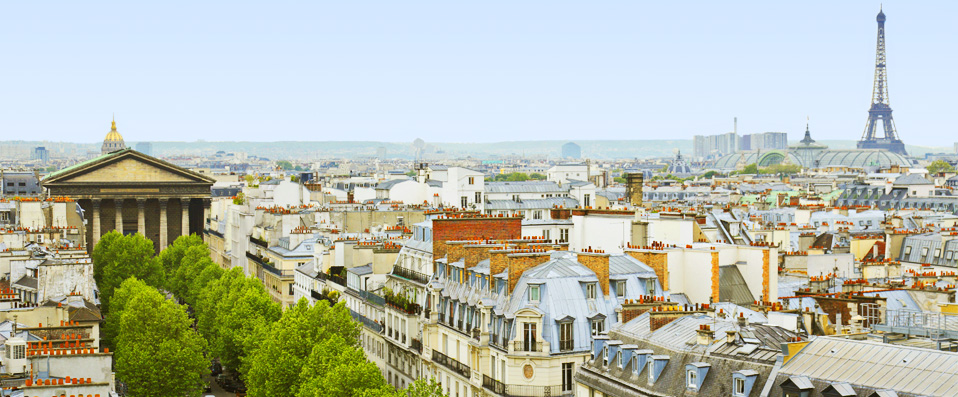
The layout of the land
First things first, let's get our bearings! Paris is divided into twenty administrative districts known as "arrondissements", each with its own unique charm. Paris' mosaic of arrondissements layed out in an unusual coil, like a snail shell spiralling clockwise out from the very middle of the city. A quick tip, to know which arrondissement you are in, take a look at the postcode, the last two numbers indicate the arrondissement, for example 75001 means the 1st arrondissement.
Of course, just to mix things up a bit, there are plenty of well-known neighbourhoods that don't conform to the arrondissments, such as the La Marais (which more or less comprises the 3rd & 4th arrondissements), the Latin Quarter (more or less contained within the 5th arrondissement), or Montmartre (contained within the 18th arrondissement).
Here, however, we will focus on the arrondissements and breakdown some of top attractions for in each:
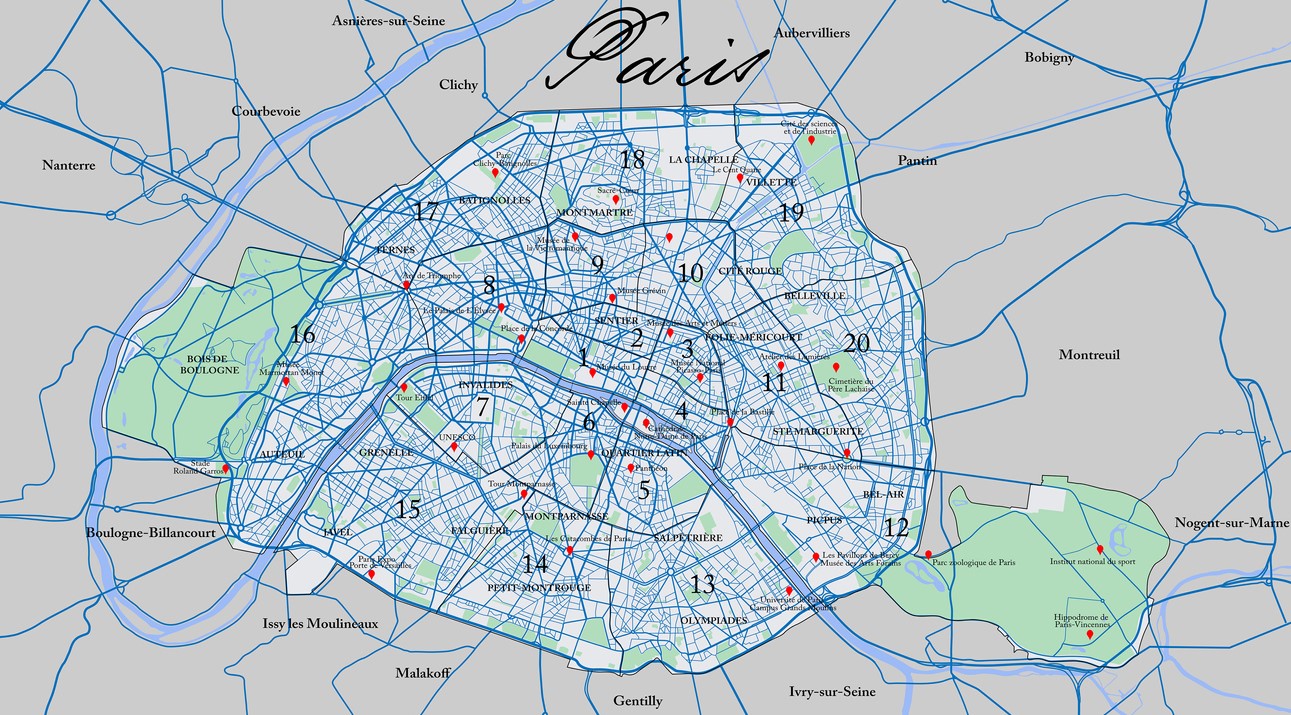
1st and 2nd Arrondissements (Louvre & Bourse)
The 1st arrondissement is part of the original heart of Paris, where a small Celtic tribe known as Parisii settled around 2,300 years ago along the Seine River. The area is home to a plethora of famous historic and cultural attractions, including the Louvre Museum, the Musée de l'Orangerie, the Sainte-Chapelle, the Conciergerie, and the historic Palais Royal with its beautiful gardens. The district is also home to the Tuileries Gardens, which offer a tranquil respite from the bustling city centre. The arrondissement is also a shopper's paradise, with everything from haute couture fashion showrooms to the famous Les Halles shopping centre. The district is home to a wide range of typical French bistros, brasseries, bakeries, and restaurants.
The 2nd arrondissement meanwhile is a small but vibrant district in the heart of Paris, sometimes overlooked by tourists. The area is home to the lively Sentier neighbourhood known for its fashion boutiques, and the Passage des Panoramas, a historic covered shopping arcade that dates back to the 19th century. It is also is also home to the Rue Montorgueil, a pedestrian-only market street that is lined with cafes, bakeries, and shops selling everything from cheese to wine to baguettes. You'll also find a multitude of upscale restaurants, designer boutiques, and 4- and 5-star hotels.
3rd and 4th Arrondissements (Temple & Hôtel-de-Ville)
Two of the most charming and historic districts in the city, as we mentioned before, these two arrondissements make up what is known as The Marais neighbourhood. You'll find a number of art galleries and museums here, such as the Musée Picasso, with an extensive collection of works by the famous artist, the Musée Carnavalet, which chronicles the history of Paris from its earliest days to the present era, and the Centre Pompidou, a modern art museum that is a must-visit destination for art lovers. Also be sure to visit the Place des Vosges, one of the most beautiful squares in Paris, and the Marché des Enfants Rouges, the city's oldest covered market. The 4th arrondissement is home to the Hôtel de Ville, the city's historic town hall, and the iconic Notre-Dame de Paris cathedral. This neighbourhood is not to be missed for art and history enthusiasts!
5th Arrondissement (Panthéon)
Another one of the oldest and most charming areas in the city, as we mentioned before, this district more or less corresponds to the popular Latin Quarter of Paris. Discover a whole host of historic and cultural attractions, including the Pantheon, a mausoleum that houses the remains of many famous French figures, and the Musée de Cluny, which houses a collection of medieval art and artifacts, and the Jardin des Plantes, a beautiful botanical garden that is perfect for a leisurely stroll. The neighbourhood is famous for its lively student atmosphere, with many universities and schools located in the area, along with wide variety of charming restaurants, cafes, and bars. This is the perfect destination for a bit of history combined with an exciting social scene.
6th & 7th Arrondissements (Luxembourg & Palais-Bourbon)
Both located in the heart of Paris’ Rive Gauche (Left Bank), the southern side of the Seine, these neighbourhoods are some of the most affluent and prestigious areas in France.
The 6th arrondissement, home to the atmospheric and upscale Saint-Germain-des-Prés neighbourhood, is quintessentially Parisian, and a chic choice for your holiday in Paris! The area is known for its quiet, leafy residential streets, stunning Haussmannian architecture, famous cafés and prized gastronomic restaurants, quaint boutiques and luxury hotels. It is one of the best walking neighborhoods in Paris, with plenty to take in. Be sure to visit the impressive Musée de Cluny – housed in a fabulous Gothic mansion and dedicated to the arts of the Middle Ages, the Musée du Luxembourg – the oldest public museum in the capital, the Jardin du Luxembourg – a serene and beautiful botanical garden, and the Odéon-Théâtre de l’Europe – a legendary site for theatrical performances.
The 7th arrondissement meanwhile, includes the historical aristocratic neighbourhood of Faubourg Saint-Germain, and is home to many national French institutions, including the National Assembly and numerous government ministries. It is also home to many diplomatic embassies, many of which are housed in incredible hôtels particuliers (grand townhouses). The district is a treasure trove of major monuments and museums, parks, fine dining, and exclusive boutiques. Of course, you can't miss the iconic Eiffel Tower, but be sure to also visit the Hôtel des Invalides (Napoleon's resting place), the La Chapelle du Grâce de Sainte Vierge Miraculeuse, as well as the variety of museums, including the Musée d'Orsay, housing classic French art, the Musée Rodin, showcasing works by the famous sculpter, and the Musée du Quai Branly – Jacques Chirac, featuring the indigenous art of Africa, Asia, Oceania, and the Americas.
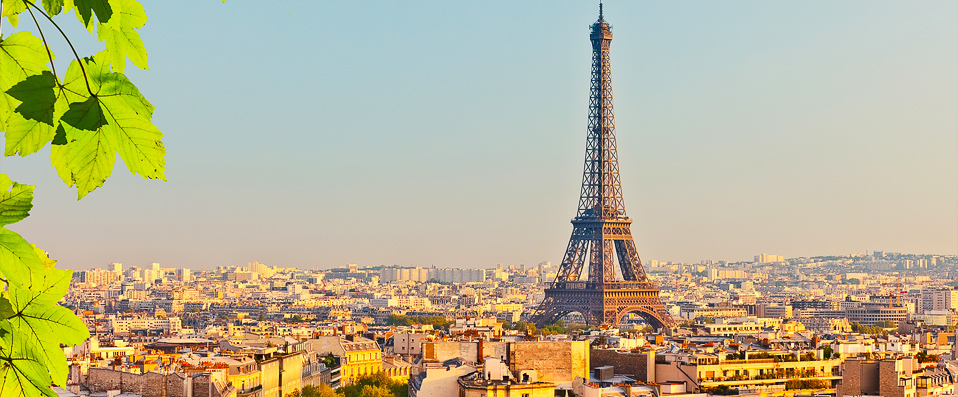
8th Arrondissement (Élysée)
"Au soleil, sous la pluie, à midi ou à minuit, Il y a tout ce que vous voulez aux Champs-Elysées!" goes the famous song by Joe Dassin. Translation: In the sun, under the rain, at midday or midnight, there is everything that you want on the Champs-Elysées! The 8th arrondissement of Paris is one of the most affluent and prestigious residential areas in France, and home to this world-famous avenue. The district is situated on the right bank of the River Seine, with many places of interest, including the Arc de Triomphe, and the Place de la Concorde. Similarly to the 7th arrondissement, it is, also home to many national French institutions, including the Élysée Palace, the official residence and office of the President of France. The area is renowned for its high-end shopping, with many luxury brands having their flagship stores on or near the Champs-Élysées. You'll also find plenty of museums, including the Musée Jacquemart-André, the Musée Nissim de Camondo, and the Petit Palais.
9th Arrondissement (Opéra)
Also located on the right bank of the Seine, and oftern referred to by its name "Opéra", this district is home to many places of cultural, historical, and architectural interest, including the Palais Garnier, and architectural gem which is home to the Paris Opera and Paris Opera Ballet. It is also instantly recognisable for its sweeping boulevards and classic Haussmannian architecture. It is another shopper's paradise with its two enormous Belle Époque grands magasins (department stores), the famous Galeries Lafayette and elegant Au Printemps, along with numerous smaller French and international stores and boutiques. While the variety of other concert halls and entertainment venues alongside the opera, stage everything from concerts to musicals, making this a prime choice of neighbourhood for those into theatre, music and nightlife.
10th Arrondissement (Entrepôt)
Heading west again along the spiral, we come to the multicultural 10th arrondissement, home to many places of cultural, historical, and architectural interest, including the Canal Saint-Martin, linking the northeastern parts of Paris with the River Seine. Importantly, this is the home of two of Paris's six main railway stations: the Gare du Nord and the Gare de l'Est, which receive most of the high-speed international trains to Paris, including the Eurostar from London. The canal, which dates from the 19th-century, enjoys a relaxed atmosphere and is perfect for picnics and boat rides. It is also lined with bars, restaurants independent boutiques. Meanwhile the historic market hall of Saint Quentin is located between the two train stations, with a multitude of different stalls with a huge variety of cuisines. The Place de la République is the neighbourhood's major square, bordering the 3rd and 11th arrondissements.
11th Arrondissement (Popincourt)
This lively urban district is a great place for fans of street art and off-the-beaten-path things to do. The district is home to the Place de la Bastille, named for the infamous Bastille prison which was located here. The busy square is now home to a number of famous monuments, including an opera house. As with many of the Parisian districts expect to find numerous sweeping boulevards with typical Haussmannian architecture, containing many local restaurants, cafes, and bars. Another interesting attraction, is the Musée Édith Piaf, which features exhibitions of personal artifacts belonging to the famous and iconic French singer, as well as a history of the wider neighborhood. Book a luxury hotel here, and it won't be long before you're singing "Non, Je Ne Regrette Rien..."
12th Arrondissement (Reuilly)
The largest arrondissement in Paris, this neighbourhood is home to the Bois de Vincennes, an enormous park known as Paris' "lungs", and another of Paris' major railway stations the Gare de Lyon, a classic example of Belle Époque architecture and the gateway to much of south eastern France. The district is once again brimming with excellent restaurants, cafes, and bars catering to Parisians who live in this side of the city, along with many fascinating museums, including the Musée des Arts Forains, which houses a collection of antique carnival rides and games, and the Cinémathèque Française, which showcases the history of French cinema. And don't miss a trip to the Marché d'Aligre, a bustling market street with a sea of fresh produce, cheese, and other delicious delicacies.
13th Arrondissement (Gobelins)
Coming back around to the west, again onto the left bank of the seine, the 13th arrondissement is a hidden gem that can be often overlooked by tourists. There is plenty to see and do, and the area is known for its thriving new arts and entertainment scene, with a nice contrast between the traditional and the contemporary. Among the many museums available to visit, is the Musée National d'Art Moderne, which houses one of the world's largest collections of modern and contemporary art. The district is also home to the Bibliothèque Nationale de France, a massive postmodern library designed by Dominique Perrault. It is possible to find some excellent luxury hotels here, which are more tranquil than the city centre, yet put you within easy reach of the nearby neighbouring Latin Quarter.
14th & 15th arrondissement (Observatoire & Vaugirard)
Both of these districts are fairly family-friendly residential districts – a great choice for finding finding excellent hotels in tranquil setting, away from the tourist crowds. Importantly, they are well-connected to the rest of Paris by public transportation – however, that isn't to say there is nothing to see or do in both districts!
The 14th arrondissement boasts some lovely parks, including the Parc Montsouris, featuring a lake, a waterfall, and numerous walking paths. The district is also home to the Observatory of Paris, a historic observatory founded in 1667, and one of the most popular, albeit macabre, attractions in Paris – the Paris Catacombs, a vast network of underground tunnels that house the bones of millions of Parisians. And a notably museums in the area, is the Musée Jean Moulin, dedicated to the French Resistance during WWII.
Meanwhile, the 15th arrondissement's many parks include the Parc André Citroën, featuring a hot air balloon that offers panoramic views of Paris, and the lush green Parc Georges Brassens. The area also boasts many restaurants, cafes, and bars, along with a number of cultural attractions, including the Musée Bourdelle, which houses the works of famous sculptor Antoine Bourdelle, and the Paris Expo Porte de Versailles, which hosts many international trade fairs and exhibitions.
16th Arrondissement (Passy)
Back over and onto the Rive Droite (Right Bank), is another of the most affluent and prestigious residential areas in France. The 16th arrondissement is known for its elegant residential neighbourhoods with stately old houses and picture-perfect art-deco buildings, fine restaurants, world-class museums, famous stadiums, and leafy parks. Among its paris is the famous Bois de Boulogne, the second largest park in Paris, and home to an English rose garden, botanical gardens, the Jardin d'Acclimatation and zoo, a handful of lakes and a waterfall. It also contains the Hippodrome horse racing track, Roland Garros (where the French Open is held), and two Michelin-starred restaurants! The district is also home to numerous museums, including the Musée Marmottan Monet, with the world's largest collection of Claude Monet's work, and the Palais de Tokyo, an important contemporary art hub. In the quiet and leafy Passy neighborhood, you'll discover many charming streets and secretive passageways, along with the Passy Cemetery, one of the city's most beautiful old cemeteries and a lovely place for a stroll. Also, one of the best place to view the Eiffel Tower is here from across the river, at the Trocadéro.
17th Arrondissement (Batignolles-Monceau)
In the north west of the city now, this district is best-known for its trendy bars, beautiful parks, and lively Batignolles neighbourhood. It is otherwise a residential district, and there are no great Parisian landmarks or monuments here. One of the biggest and most serene parks is the Martin Luther King Park, which is one of the best places to enjoy cherry blossoms in Paris during the spring. The Batignolles area is concentrated around the Square des Batignolles, which is home to an English landscape garden, café terraces spilling out into the streets, and a myriad of independent boutiques and shops. The main streets which make up the Batignolles area include rue des Dames, Rue Legendre and Boulevard des Batignolles.
18th Arrondissement (Butte-Montmartre)
A vibrant, diverse, and... hilly Parisian district! This is where you will find the iconic Montmartre neighbourhood, formerly a village of the same name, set high up on the hill above Paris. This neighbourhood has been been the gathering place for, or even home to, countless famous (and less-than-famous) creatives over the years, including Picasso and Vincent van Gogh. Atop the hill, the big white Sacré-Cœur Basilica is one of the most famous landmarks in Paris and offers stunning views of the city. Meanwhile, down below, you'll find the Moulin Rouge, the iconic cabaret famous for its can-can dancers. The many museums here, include the Musée de Montmartre, dedicated to the history of Montmartre, and the Musée de la Vie Romantique, dedicated to the Romantic era in France. Parks include the beautiful Parc des Buttes-Chaumont, featuring a lake, waterfall, and numerous walking paths. And the arrondissement also comprises the lively, bustling neighborhoods of Barbes and La Goutte d'Or. Overall, this district features in countless stories, movies and television series, and if not the location of your hotel, then certainly a must-visit during your Paris holiday.
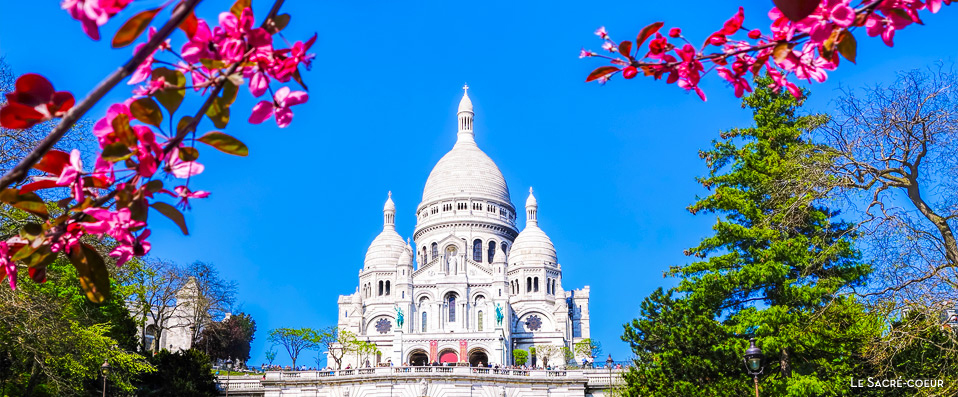
19th & 20th Arrondissements (Buttes-Chaumont & Ménilmontant)
Both of these districts in the northeast of Paris are a little further away from the city centre, and are perfect for those looking to escape the crowds and experience a unique, offbeat Paris. The neighbourhood and former town of Belleville, which means "beautiful town", straddles these two districts. Traditionally working-class, this somewhat gritty yet characterful neighbourhood has become increasingly popular with artists and students in recent years, with plenty of fantastic street art scattered around, buzzing galleries and workshops (ateliers) that are frequently open to the public.
The culturally rich 19th arrondissement is home to two of the city's largest parks, the beautiful Parc des Buttes Chaumont, and the popular Parc de la Villette. The latter is a museum-and-music-filled park, hosting an outdoor cinema in summer, and home to the Philharmonie de Paris music complex, is a cultural hub for music lovers. The district is also known for its waterways, with two canals coming together from the east and north of France, that lead into the Canal St Martin followed by the Seine. The Cité des Sciences et de l'Industrie is the biggest science museum in Europe, with a planetarium, IMAX theater, and impressive collection of interactive, science exhibits. The district is also home to the Grande Halle, which hosts all kinds of fairs and cultural events.
While in the 20th Arrondissement, be sure to visit the Père-Lachaise Cemetery, which is the final resting place of many famous French and international figures, from Marcel Marceau and Edith Piaf, to Jim Morrison and Oscar Wilde.
What to do in Paris for free?
We've covered many of the key sights and attractions for each of the Paris districts. However, whether on a cram-packed short break or a long getaway, life can seem expensive in the French capital. The good news is there are many free activities in Paris to provide a little relief to your wallet. Here are some of our recommendations:
- Leisurely strolls! Paris is a beautiful city, and one that lends itself to strolling around. Aside from the very centre of Paris, we recommend in particular the neighbourhoods of:
- Montmartre
- Latin Quarter
- Saint-Germain-des-Prés
- Passy and Chaillot (with the Trocadéro)
- Belleville
- Free museums – many museums in Paris offer free access to their permanent collections. This is the case of the Shoah Memorial, the Museum of Modern Art or the Carnavalet Museum. Others are accessible free of charge every first Sunday of the month, notably the Center Pompidou, the Musée des Arts et Métiers, or the Musée d’Orsay.
- Free parks – despite significant urbanisation and being the country's largest city, the French capital is fortunate to have a great number of parks. They are green havens of where you can come to walk, lie down and sunbathe, and find numerous sights and activities. We recommend in particular:
- The Champs-de-Mars: hard to miss this is the park that lies at the foot of the Eiffel Tower.
- The Jardin des Tuileries and the Jardin du Luxembourg: perhaps the “French-style” of the city's parks.
- The Jardin des Plantes: the most exotic, as the park is home to many different botanical gardens
- The Bois de Boulogne: formerly the royal hunting grounds, this is the second largest park in Paris with with lakes, nature trails & botanical gardens.
- The Bois de Vincennes: located just outside the city centre, this beautiful and extensive park is the largest in the city.
- The Parc des Buttes-Chaumont: is perhaps the most picturesque, with its footbridges and its small kiosk at the top of a rocky mound.
- The Parc de la Villette: we mentioned it before, this park with its wide lawns, sculptures and fountains, contains a museum, cinema and a music complex.
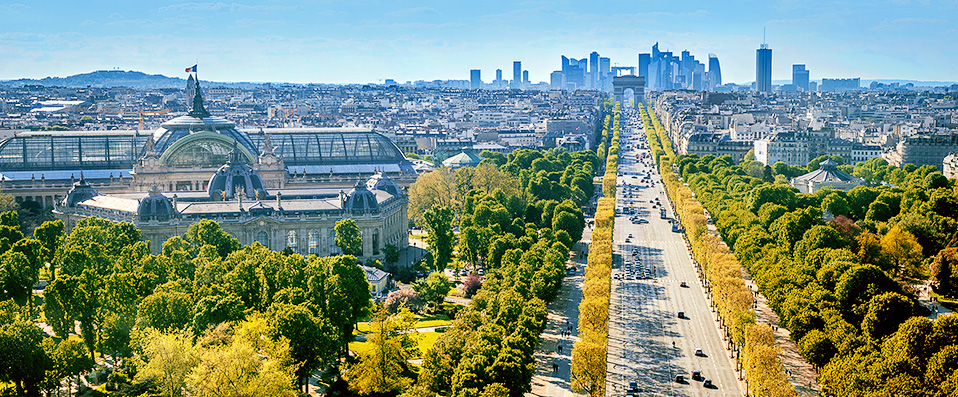
When is the best time for a trip to Paris?
The best time to visit Paris is from May to October, when the café terraces are liveliest and outdoor events are most frequent.
Of course, the best time to visit Paris depends largely on personal preferences, however, it's safe to say that each season in Paris offers its own unique charm and set of activities. In the words of the legendary Audrey Hepburn, "Paris is always a good idea". That said, temperatures can drop close to 0°C in winter, and exceed 30°C in the height of summer, so be prepared!
- Spring, spanning from April to June, is a favoured time to visit Paris. The city blooms with colourful flowers, particularly in April, creating a picturesque atmosphere. The mild weather during spring allows for pleasant strolls through the parks and along the Seine River, for picnics by the canals, or wandering city's charming streets. Additionally, this season marks various cultural events and festivals, such as Fête de la Musique in June, celebrating music throughout the city.
- Summer, from July to August, sees warm weather and beautiful sunny days, inviting outdoor activities and dining at sidewalk cafes. This is peak tourist season, however, and it can get crowded, especially around iconic landmarks like the Eiffel Tower. This is a great time to perhaps explore some of the lesser-frequented neighbourhoods, a little further from the city centre, or day-trips out of the city.
- Autumn, from September to November, brings slightly cooler temperatures, fewer crowds and beautiful autumnal colours. This is an excellent time for museum visits and exploring Parisian parks.
- Winter, from December to February, sees fewer tourists, offering a quieter experience. Paris adorns itself with festive lights and decorations during the holiday season, creating a magical atmosphere, and you can find some delightful Christmas markets. However, it can be chilly, so dress warm!
Conclusion
A holiday in France offers so many possibilities, but your first stop if you have never been before, should probably be the legendary French capital. Paris encapsulates a unique blend of history, culture, and chic sophistication, and there is so much to do and see, it's impossible to even do everything there in just one trip. But by acquainting yourself with the distinct flavours of each arrondissement, you can plan the ideal getaway. And with a little help from VeryChic, you can find the ideal hotel, to add a touch of luxury to your holiday in the enchanting city of Paris.
